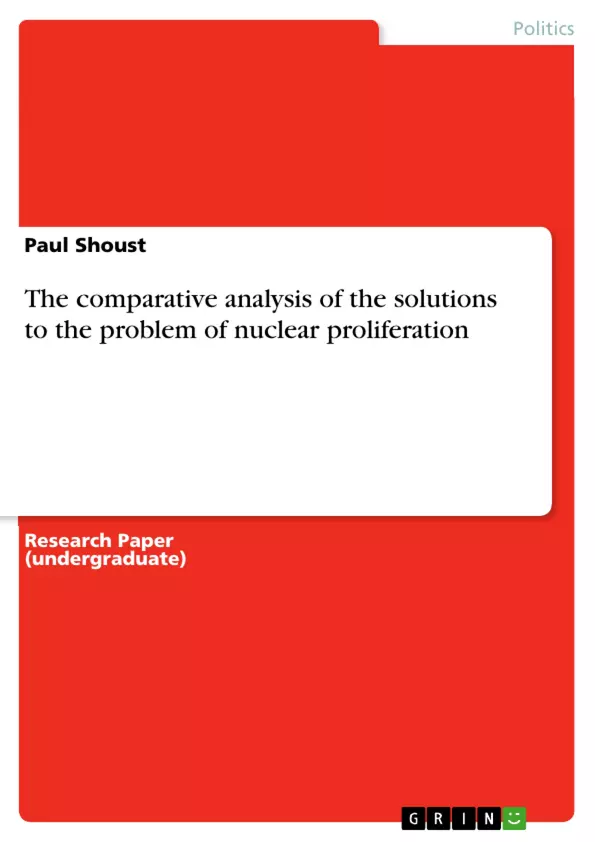The world has not become safer in the 21st century. But there is only limited number of really global threats. Those include, inter alia, international terrorism, climate change, and the issue of nuclear proliferation.
In its Resolution on the Convention on the Prohibition of Use of Nuclear Weapons, the UN General Assembly underlined that “the use of nuclear weapons poses the most serious threat to the survival of mankind” . But despite a nearly universal recognition of the threat posed by the mere existence of the nuclear arsenals, the issue of further nuclear proliferation among the members of the international community is yet to be solved.
In this paper, we attempt to conduct a comparative analysis of possible approaches to the issue of nuclear proliferation. The goal of the research, however, is not the elaboration of practical solution of the issue. We will focus on the conceptual value of the one or another option, instead. The aim is to define main dimensions of the problem that can be faced by the international community: be it in the universal fora (e.g., the UN General Assembly) or in the ‘exclusive clubs’ (the UN Security Council).
First part will be dedicated to the theoretical approaches that may be employed in the research. Also, the framework for the comparative analysis per se will be defined.
In the second part of the paper, we will focus on the determination of factors that should be taken into account during the comparative evaluation of the solutions.
In the third part, the set of factors will be applied to the potential solutions; and we will try to define common and specific characteristics of every option.
There are a lot of competent research papers dedicated to the problem of nuclear proliferation. Many of them were published before the end of the Cold War and, therefore, provide us with the dynamic view on the issue. Most of the literature used in the paper is dedicated to the problem of the theoretical and legal dimensions of the nuclear proliferation. A number of international documents were used as well: the Nonproliferation Treaty, the UN General Assembly Resolutions, etc. Mass-media sources proved to be a rich source of information. Additional information was derived from the statistical data publications, caselaw of the International Court.
Inhaltsverzeichnis (Table of Contents)
- Introduction.
- Theoretical framework
- Specific nature of the nonproliferation regime..
- Potential solutions to the problem of nuclear proliferation.
- The analysis of the nuclear proliferation solution options...........
- Complete nuclear disarmament.
- Securing status-quo
- Regional proliferation of nuclear weapons..
- Universal proliferation of nuclear weapons.....
- The spectrum of options - different approaches
- Conclusions.
- References:
- Annex 1
Zielsetzung und Themenschwerpunkte (Objectives and Key Themes)
This paper provides a comparative analysis of potential approaches to the issue of nuclear proliferation. The research focuses on the conceptual value of each option rather than proposing a practical solution. The aim is to define the main dimensions of the problem that can be addressed by the international community, whether in universal forums like the UN General Assembly or in exclusive groups like the UN Security Council.
- Examining the theoretical framework for analyzing nuclear proliferation.
- Identifying and evaluating potential solutions to the issue of nuclear proliferation.
- Analyzing the factors influencing the effectiveness of each approach.
- Highlighting the common and specific characteristics of each potential solution.
- Providing a broader understanding of the nuclear nonproliferation policy landscape.
Zusammenfassung der Kapitel (Chapter Summaries)
The introduction sets the context of nuclear proliferation as a global threat and highlights the ongoing struggle to find a solution. The paper aims to conduct a comparative analysis of potential approaches, focusing on their conceptual value rather than practical implementation.
The theoretical framework chapter discusses the most appropriate approach for the comparative analysis, particularly emphasizing the theory of international regimes. It explains how this approach allows for incorporating multiple factors and actors into a cohesive model, making it suitable for analyzing nuclear proliferation.
The chapter on potential solutions outlines various options, including complete nuclear disarmament, securing the status quo, regional proliferation, and universal proliferation. The following sections delve deeper into the analysis of these options, examining their strengths and weaknesses based on a set of carefully defined factors.
Schlüsselwörter (Keywords)
Nuclear proliferation, international regimes, comparative analysis, theoretical framework, nonproliferation, disarmament, status quo, regional proliferation, universal proliferation, international relations, international community, UN General Assembly, UN Security Council.
- Quote paper
- Paul Shoust (Author), 2010, The comparative analysis of the solutions to the problem of nuclear proliferation, Munich, GRIN Verlag, https://www.grin.com/document/162280



